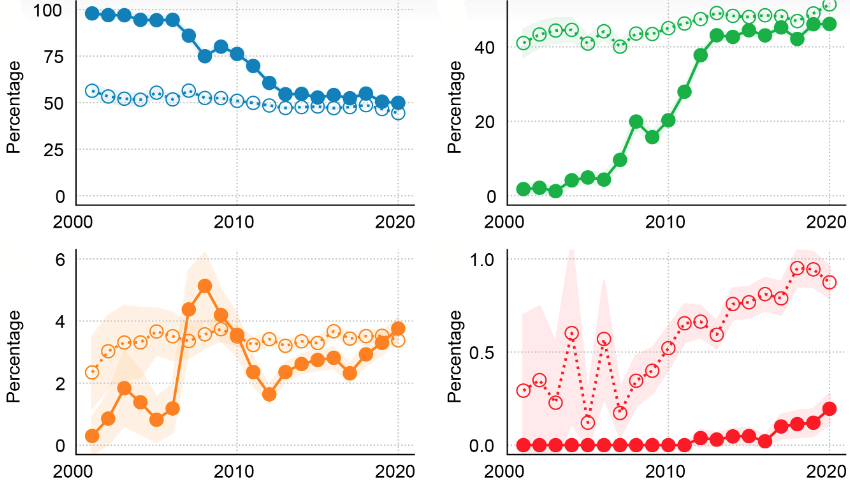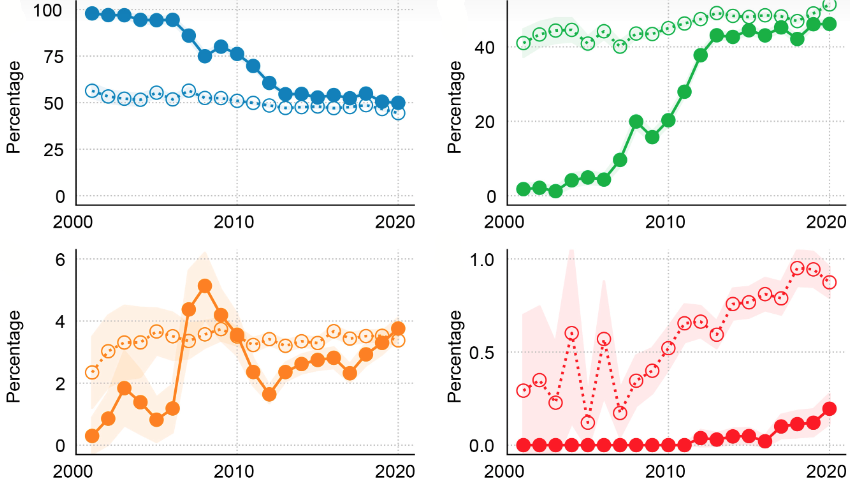Racial Inequity in Key Publication Metrics
Publish or perish. So goes the axiom warning academics to publish original findings frequently if they want to pursue and maintain a research career. However, studies have found that the publication landscape is far from a flat playing field. For example, in many fields of science, women researchers are significantly underrepresented in the authorship of published papers as well as in the reference lists of those papers (see News Feature: The Uneven Spread of Citations).
Now Bedoor AlShebli of New York University Abu Dhabi, United Arab Emirates, and her colleagues add to the growing evidence for publication inequities by showing that—in all countries and in all scientific fields—non-white researchers are underrepresented on journal editorial boards and have longer wait times for publishing their research, a previously undocumented finding [1]. The data also show that racially minoritized groups are less likely to be cited than their white counterparts. Taken together, the team says that these findings highlight the important publishing-related challenges faced by non-white scientists.
“This work serves as an important reminder that science is a global endeavor and accordingly suffers from inequity on a worldwide scale,” says Erin Teich of Wellesley College in Massachusetts, who has looked at citation inequities in physics and neuroscience. Teich was not involved in this new study. “Studies like this are critical for providing a comprehensive and data-driven examination of inequity so that we can address the problem as a global scientific community.”
In their work, AlShebli and her colleagues analyzed the data from one million scientific papers published between 2001 and 2020. These papers appeared in journals, such as the Proceedings of the National Academy of Sciences (PNAS) and PLOS ONE, that publicly display the name and institution of the editorial board member that handled the paper. The team used a race-based database to determine the most likely race of each editor and author from their full names.
They considered four racial groups—Asian and Pacific Islander, Black, Hispanic, and white. Other racial groups were initially included in the analysis but then excluded because of the small numbers of editors and authors that the software placed in those groups. The country assigned to each editor and author was determined by their affiliation in the paper.
Looking first at the country-of-work of the journal editor, the team finds that researchers working in most Asian, African, and South American countries have significantly lower representation on editorial boards (19%) than is expected based on their shares of the authorship (35%). The group finds the opposite trend for countries such as the US, Canada, UK, and Australia. For example, researchers based in the US account for 22% of the authors and 36% of the editors, an overrepresentation of 64%, while researchers in South Korea make up 2.2% of the authors and 0.61% of the editors, an underrepresentation of 72%.
To look at the racial distributions of editorial boards, the team considered only scientists affiliated with US universities. The analysis shows that in 2001, white scientists were markedly overrepresented on editorial boards with close to 100% of the editors being white, as compared to 60% of the authors from that same year being white. Over the next two decades, that overrepresentation has dropped to the point where the percentage of white editors is now roughly equal to the percentage of white authors (both around 50%). Correspondingly, the underrepresentation of editors from other racial groups—specifically Hispanic and Asian and Pacific Islander—has diminished. For Black scientists, however, that underrepresentation has increased, with Black scientists today making up just a few tenths of a percent of the editorial boards that the team studied.
Black scientists in the US also fare worse when it comes to citation rates. The team finds that Black (as well as Hispanic) scientists across fields are significantly undercited, while white scientists are overcited—a finding consistent with previous discipline-specific studies. As for the typical acceptance delay—the number of days between a paper’s submission and its acceptance for publication—Black scientists again come out at the bottom. On average, a paper with mostly Black authors spent 22% longer in the review process compared to other papers published in the same journal in the same year. The team also finds that papers by authors based in Asia, Africa, and South America have longer acceptance delays than those in other continents.
It is these publication-time findings that other scientists find most notable. “The most concerning finding to me is the relative acceptance delay between Black and non-Black US-based authors,” says Molly King, a sociologist at Santa Clara University, California. “If Black scholars experience longer times to acceptance, as this [study] suggests, then that may put their employment and tenure at risk.” Physicist-turned-sociologist Charles Gomez of the University of Arizona agrees. “In many scientific fields, time is of the essence and not being ‘scooped’ by other researchers is critical not only to disseminating important findings but also to careers. Extended delays could have profoundly adverse effects on researchers from these backgrounds and regions and hurt the wider enterprise more broadly.”
The reasons for the increased delay times remain unclear—they were not considered in this study. Margaret Brandeau, an engineer at Stanford University who has studied editorial board diversity, thinks that question deserves further attention. “I was surprised that the review process is longer for underrepresented individuals and wonder how much of the length of the process is due to editor time versus author revision time,” she says. AlShebli says that the group was unable to consider this factor in the analysis because of a lack of data on the times for the intermediary steps of the publication process. Also deserving of further study is the possible bias of the model used for the name-based inference of race. “The race ascribed to authors by these algorithms may differ substantially from [their] self-described racial identities,” King says. This limitation is only briefly discussed in the paper, she says.
But even with those drawbacks, Teich, King, Gomez, and Brandeau all commended the study. “Science succeeds when diverse voices are included, and merit and reward are allocated fairly,” Gomez says. “This [study] further supports the worrying finding that science and academia disproportionately reward and give attention to researchers who come from privileged places and backgrounds,” Gomez says. He and the other interviewed scientists hope that all editorial boards will pay attention to these findings, but they have varying degrees of optimism as to whether meaningful systemic changes will happen in the short term. “It’s difficult to imagine how this gap could close any time soon,” Gomez says.
–Katherine Wright
Katherine Wright is the Deputy Editor of Physics Magazine.
References
- F. Liu et al., “Non-White scientists appear on fewer editorial boards, spend more time under review, and receive fewer citations,” Proc. Natl. Acad. Sci. U.S.A. 120 (2023).







